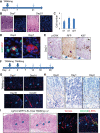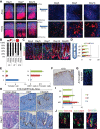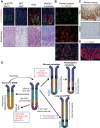Mature gastric chief cells are not required for the development of metaplasia
- PMID: 29345968
- PMCID: PMC6732738
- DOI: 10.1152/ajpgi.00351.2017
Mature gastric chief cells are not required for the development of metaplasia
Abstract
During human gastric carcinogenesis, intestinal metaplasia is frequently seen in the atrophic stomach. In mice, a distinct type of metaplasia known as spasmolytic polypeptide-expressing metaplasia (SPEM) is found in several inflammatory and genetically engineered models. Given the diversity of long- and short-term models of mouse SPEM, it remains unclear whether all models have a shared or distinct molecular mechanism. The origin of SPEM in mice is presently under debate. It is postulated that stem or progenitor cells acquire genetic alterations that then supply metaplastic cell clones, whereas the possibility of transdifferentiation or dedifferentiation from mature gastric chief cells has also been suggested. In this study, we report that loss of chief cells was sufficient to induce short-term regenerative SPEM-like lesions that originated from chief cell precursors in the gastric neck region. Furthermore, Lgr5+ mature chief cells failed to contribute to both short- and long-term metaplasia, whereas isthmus stem and progenitor cells efficiently contributed to long-term metaplasia. Interestingly, multiple administrations of high-dose pulsed tamoxifen induced expansion of Lgr5 expression and Lgr5-CreERT recombination within the isthmus progenitors apart from basal chief cells. Thus we conclude that short-term SPEM represents a regenerative process arising from neck progenitors following chief cell loss, whereas true long-term SPEM originates from isthmus progenitors. Mature gastric chief cells may be dispensable for SPEM development. NEW & NOTEWORTHY Recently, dedifferentiation ability in gastric chief cells during metaplasia development has been proposed. Our findings reveal that lesions that were thought to be acute metaplasia in fact represent normal regeneration supplied from neck lineage and that isthmus stem/progenitors are more responsible for sustained metaplastic changes. Cellular plasticity in gastric chief cells may be more limited than recently highlighted.
Keywords: Lgr5; gastric chief cell; metaplasia; stem cell.
Conflict of interest statement
No conflicts of interest, financial or otherwise, are declared by the authors.
Figures








Similar articles
-
Spasmolytic polypeptide-expressing metaplasia (SPEM) in the gastric oxyntic mucosa does not arise from Lgr5-expressing cells.Gut. 2012 Dec;61(12):1678-85. doi: 10.1136/gutjnl-2011-301193. Epub 2011 Dec 23. Gut. 2012. PMID: 22198711 Free PMC article.
-
Maturity and age influence chief cell ability to transdifferentiate into metaplasia.Am J Physiol Gastrointest Liver Physiol. 2017 Jan 1;312(1):G67-G76. doi: 10.1152/ajpgi.00326.2016. Epub 2016 Nov 23. Am J Physiol Gastrointest Liver Physiol. 2017. PMID: 27881402 Free PMC article.
-
Metaplastic Cells in the Stomach Arise, Independently of Stem Cells, via Dedifferentiation or Transdifferentiation of Chief Cells.Gastroenterology. 2018 Mar;154(4):839-843.e2. doi: 10.1053/j.gastro.2017.11.278. Epub 2017 Dec 14. Gastroenterology. 2018. PMID: 29248442 Free PMC article.
-
The origin of pre-neoplastic metaplasia in the stomach: chief cells emerge from the Mist.Exp Cell Res. 2011 Nov 15;317(19):2759-64. doi: 10.1016/j.yexcr.2011.08.017. Epub 2011 Aug 31. Exp Cell Res. 2011. PMID: 21907708 Free PMC article. Review.
-
Current understanding of SPEM and its standing in the preneoplastic process.Gastric Cancer. 2009;12(4):189-97. doi: 10.1007/s10120-009-0527-6. Epub 2010 Jan 5. Gastric Cancer. 2009. PMID: 20047123 Free PMC article. Review.
Cited by
-
R-spondin 3 governs secretory differentiation in the gastric oxyntic glands.J Clin Invest. 2022 Nov 1;132(21):e163380. doi: 10.1172/JCI163380. J Clin Invest. 2022. PMID: 36317629 Free PMC article.
-
Stem Cell Biomarkers and Tumorigenesis in Gastric Cancer.J Pers Med. 2022 Jun 3;12(6):929. doi: 10.3390/jpm12060929. J Pers Med. 2022. PMID: 35743714 Free PMC article. Review.
-
Role and research progress of spasmolytic polypeptide‑expressing metaplasia in gastric cancer (Review).Int J Oncol. 2024 Mar;64(3):33. doi: 10.3892/ijo.2024.5621. Epub 2024 Feb 1. Int J Oncol. 2024. PMID: 38299264 Free PMC article.
-
Iqgap3-Ras axis drives stem cell proliferation in the stomach corpus during homoeostasis and repair.Gut. 2021 Oct;70(10):1833-1846. doi: 10.1136/gutjnl-2020-322779. Epub 2020 Dec 8. Gut. 2021. PMID: 33293280 Free PMC article.
-
Stem cells and origins of cancer in the upper gastrointestinal tract.Cell Stem Cell. 2021 Aug 5;28(8):1343-1361. doi: 10.1016/j.stem.2021.05.012. Epub 2021 Jun 14. Cell Stem Cell. 2021. PMID: 34129814 Free PMC article. Review.
References
-
- Barker N, Huch M, Kujala P, van de Wetering M, Snippert HJ, van Es JH, Sato T, Stange DE, Begthel H, van den Born M, Danenberg E, van den Brink S, Korving J, Abo A, Peters PJ, Wright N, Poulsom R, Clevers H. Lgr5(+ve) stem cells drive self-renewal in the stomach and build long-lived gastric units in vitro. Cell Stem Cell 6: 25–36, 2010. doi:10.1016/j.stem.2009.11.013. - DOI - PubMed
Publication types
MeSH terms
Substances
Grants and funding
LinkOut - more resources
Full Text Sources
Other Literature Sources
Medical

